| | | 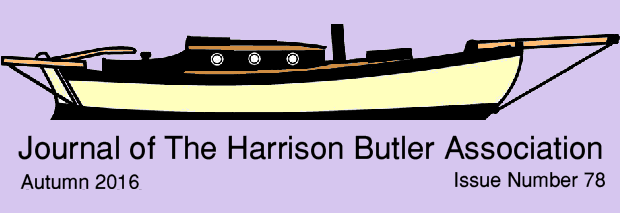
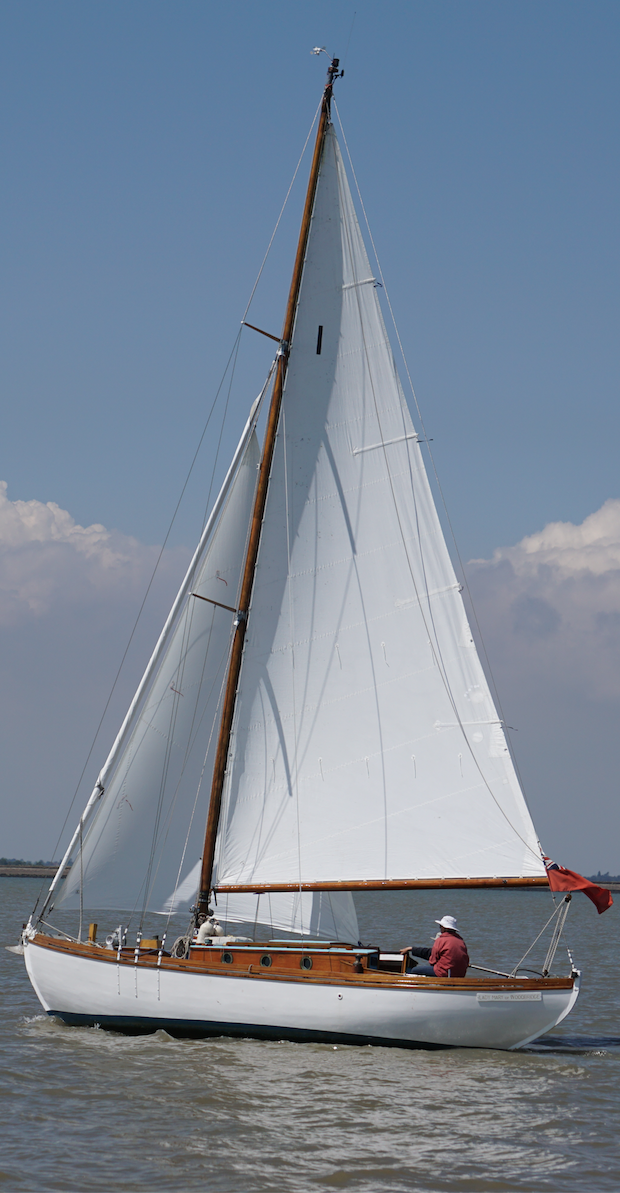
The Lady Mary of Woodbridge on the River Crouch, 2016
Photograph taken by Jan van der Schans
The Journal of The Harrison Butler Association
Editor : Martin Hansen
Proof Reading : Dr Helen Jones
Far East Correspondent : Dr Stephen Davies
Australian Correspondent : David Stamp
Netherlands Correspondent : Michiel Scholtes
Baltic Correspondent : Myriam Spicka
UK Correspondent for The Solent : Robert Griffiths
UK Correspondent for Dartmouth : Allen Clarke
Contributions for the Journal are most welcome be they
fully formed articles, rough notes or snippets of News.
If you feel you would like to contribute on a regular basis,
applications to join our growing network
of correspondents are also invited.

In a recent BBC News item the cost of a basket of shopping at a Tesco store in Southern Ireland, priced in Euros, was compared with identical goods in a Northern Ireland Tesco store, priced in Pounds. The News team picked Tesco following their public stand off with Unilever who own many popular brands such as Pot Noodle and Marmite. In a marketing coup a couple of weeks earlier, Tesco had refused to bow to pressure from Unilever to increase its UK store prices of their products. As the impasse continued, Tesco began removing Unilever's products from its website and threatened to do likewise across its stores unless Unilever backed down. Unilever backed down. Hence the News item of shoppers from Southern Ireland heading North to cross the border and save 20% on the cost of their groceries.
If I were a Yacht Broker in the UK right now, I'd be planning to expand my advertising in the EU, especially across the Channel in France, Belgium, the Netherlands and Germany. Come the Spring of 2017, boats priced in Pounds are going to seem surprisingly cheap to our Continental cousins.
A year ago, £1 cost €1.43. Now £1 costs €1.15. This is a fall of 19.6%. So that boat that used to cost €10,000 can now be yours for €8,041 - “As it's you Sir, let's call that €7,999. Have we a deal” ?
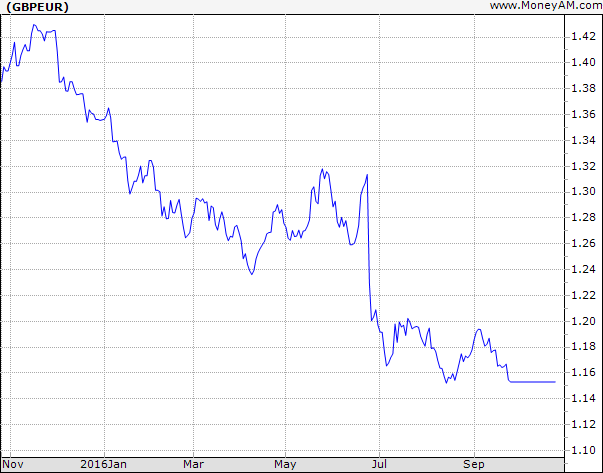
The fall of the Pound relative to the Euro over the last year

!•¡•! Patrick Burgess is the author of Geoff Taylor : Transatlantic Yachtsman, a book about Watermaiden's many crossings of the Atlantic under Geoff's command between 1979 and 2008. The book, still at the proof reading stage, also describes Geoff's career in the oil exploration industry and his development with Patrick of navigation software that was to be marketed as an alternative to GPS. As soon as the book is commercially available, a News Feed announcement will be made.
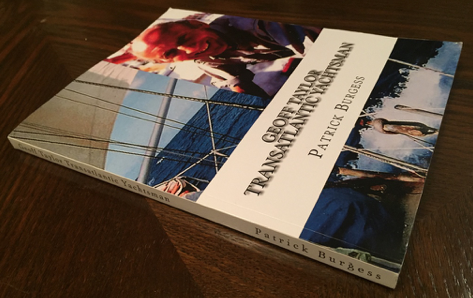
!•¡•! Practical Boat Owner is to feature an article on Harrison Butler designed boats. The piece is being written by Peter Poland who has contacted several HBA Members to ensure technical accuracy and to source a few lively and interesting anecdotes. The item is tentatively penciled in to appear in the either the January or February 2017 issue.
!•¡•! Several desirable boats built to Harrison Butler designs have recently come onto the market including Amiri, Isabella, Jacaranda, Little Kingfisher, Watermaiden, Zingara and Zircon. Mayfly also came onto the market with The Classic Yacht Brokerage but sold immediately. Also sold since the last issue of the HBA Journal was published are Omega of Broom, Mytica and the Albert Strange designed Leona.
!•¡•! Congratulations to Craig Nutter and crew of Sabrina who won the regatta class at the inaugural Hamble Classic Regatta 2016. Vindilis, Destina, Mischief III and Little Kingfisher also enjoyed the eventful weekend.

Craig Nutter & crew plus the hard won glassware
Sir Robin Knox-Johnston,
Lindy II & The Cattewater Trophy
Mary Goodhand

In 1989 my husband Ron and I were returning in Lindy II from our Brittany cruise and picked up a mooring off the Plymouth Yacht Club. We were made most welcome at the club and, although initially reluctant, were persuaded to enter Lindy II in the coming weekend's Classic Rally. A few traditional yachts were already moored off the club when we arrived and the following day were joined by many more, all rather smartly turned out. Although we considered ourselves and the boat rather travel-stained, we good naturedly joined in and cleaned up as much as possible. On the Friday evening the various owners spent an interesting time visiting each other's yachts and discussing modifications and performance. Robin Knox-Johnston, who was there with Suhaili, came aboard Lindy II. Ron was very pleased when he expressed an interest in our saloon table. Ron promised to draw up a plan of the well designed structure which sinks into the cabin sole when under way, giving free passage through the saloon.
All boats were officially viewed the following day and various races organised. We had elected not to race but joined the flotilla as they sailed a course set in the Hoe. The weather was perfect and Lindy II sailed beautifully. We had a splendid evening in the yacht club and were instructed to gather for results and presentations the following morning. It was a gathering of friends, but none of them had told us that Robin was one of the judges and was to present the prizes. When most prizes had been distributed there remained only the prestigious Plymouth Classic Boat Rally Cattewater Trophy. Imagine our surprise when our name was called and Lindy ll pronounced a worthwhile winner by Robin Knox-Johnston. A thunderous applause suggested many concurred with Robin's judgement. As he presented the trophy to Ron, he declared that he would step aboard Lindy II at a moments notice, then to sail anywhere in the world. What an accolade ! The cup was filled with cider and passed around enthusiastically. We received compliments from all directions on owning such a beautiful boat. For me the greatest praise of all came from the wife of another judge; “I know nothing at all about sailing or yachts but I've never seen a prettier sight than your yacht under sail”.
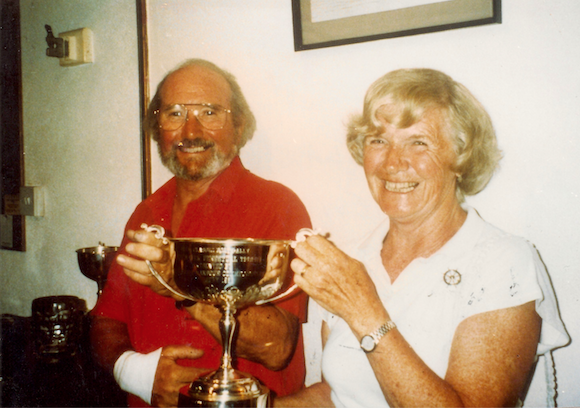
Ron and Mary Goodhand holding the Cattewater Trophy, 1989.
Following this event Robin Knox-Johnston became a member of the HBA
and subsequently appeared in Brian Hawkin's BBC Documentary about
the boats designed by Harrison Butler.
Lindy II continues to 'turn heads' under current custodian, Robert Griffiths.
Pleasure Tool Two
Peter Crook
The HBA's Treasurer
I rather enjoyed Martin's editorial, Pleasure Tool, in the Summer 2016 issue of The HBA Journal extolling the usefulness, when working in an awkwardly small space, of his two 'stubbies'; screwdrivers of only 10 cm shaft length. However, I can go one better with my Confined Space Ratchet Driver. It's £21.36 on Amazon, but a bargain £5.86 + £1 P&P from Axminster Tools.

Peter Crook's Confined Space Ratchet Driver.
Peter is HBA Treasurer and owner of Cautious Clara.
If any other reader has a Pleasure Tool to recommend, let us know.
Ganga Devi - Part III
~ Not A Drop To Drink ~
JOC Alexander
At Singapore Rupert French left us, having endured Ganga Devi's life endangering passage across the South China Sea. He was heading to Australia to crew in the Sydney-Hobart race. That left Hugh Burt and me to sail the 500 mile passage to Port Dickson, half way up the West coast of Malaya. A five day voyage saw us arrive late on the evening of 31st December, just in time to join in the New Year celebrations and welcome in 1961. With Rupert's replacement, Adrian Corkhill, aboard we sailed at noon the following day, seen off in style by an Army Pipe Band.
Our nineteen day passage across the Bay of Bengal to Ceylon (now called Sri Lanka) was characterised by cracking good sailing, the boat managing a steady 4 to 5 knots under clear skies in reasonably flat water. In the port city of Colombo Hugh and Adrian secured land based accommodation but I remained aboard to work on the rigging and show off the boat to some VIPs. They arrived to find me semi-conscious on the deck with blood running from the scuppers; I'd fallen 25 feet from the top of the mast, hitting my head as I landed on the edge of Ganga Devi's steel coaming. My scalp wound needed 18 stitches and bed rest.
On January 25th the three of us set sail from Colombo, a 2,500 mile passage ahead, across the Indian Ocean to Aden. Aboard was 34 gallons of precious drinking water, the most we could safely carry. Insufficient to see us across, and with rain unlikely at this time of year, we planned a half way stop at a coral atoll called Minikoi. It had the extraordinary property of coral that filters seawater such that if a hole is dug in the beach, six feet from the waters edge, brackish but drinkable freshwater is found. We thought about this more and more as feeble winds reduced our 24-hour daily runs to between 10 to 14 miles. Then for six days we were completely becalmed, cut the water ration from 4 to 3 pints each per day, and resorted to rowing with the cockpit floorboards tied to spinnaker poles - we needed to feel that we were doing something, anything, to resolve our plight. Late one night, on the verge of a desperate decision to try and make it back to Colombo, we saw a loom of light ahead; Minikoi's lighthouse ! Following a local fishing boat through seas festooned with coral heads we anchored off the atoll's settlement. After swimming ashore, we found that, as white men, we were real curiosities, but welcomed warmly all the same.
We left our Tropical Paradise of rice, fish and coconuts on 10th February having engaged a native pilot to get us through the circular barrier reef and coral heads that was more treacherous than our dehydrated minds had appreciated on the way in. Ganga Devi made good headway in excellent sailing conditions. In fact, for much of the time, she sailed herself, as one would expect of a Harrison Butler design. This left us free to catch fish which made a pleasant change from the Army tinned curry we'd stocked up with in Malaya. The prize for catching the biggest fish went to Hugh, who, as it turned out, would rather not have received it. Using a long strip of red shirt with a hook on the end he hauled a big fish aboard. To our horror we realised it was a shark, seven feet in length, and not in a good mood. It thrashed around snapping, each chomp reducing another piece of one inch thick teak cockpit side to firewood. Using the boathook and spinnaker poles the three of us managed a coordinated manoeuvre that levered the flailing beast back into the sea.
On the 1st of March 1961 we secured to a mooring at the Aden Services Yacht Club where we were given a terrific welcome.
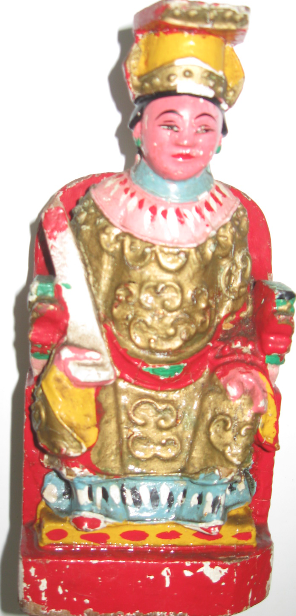
A photograph of the actual plaster statue of Tin Hau carried
aboard Ganga Devi on her voyage from Hong Kong to Falmouth.
Tin Hau is a goddess who offers protection to sailors.
Simon Wagner (1964-2016)
John-Henry Bowden
Chairman of The Harrison Butler Association
Members of The Harrison Butler Association were shocked and saddened to hear last May of the death of Simon Wagner. Simon was well known to us as a joint custodian and restorer of the Harrison Butler designed Z4, Zest, between 1990 and 2004 and also as our Treasurer between 1995 and 1998. Simon, also an enthusiastic marathon runner and cyclist, died in a tragic accident on 5th May 2016 aged only 52. We send our sincere sympathies to his wife, Linda, their three children, and his mother, Beryl.
Beryl has very kindly sent us an account of Simon's custodianship of Zest from which I have been privileged to compile this brief obituary of him and his boat, in his honour. Simon and two friends originally discovered Zest in November 1990 in the River Medina, Isle of Wight. She was in a very poor state of repair, with a cabin that was clearly not original, and they bought her with the dream of restoring her to her former glory. Simon's notes to his joint owners from that time show clearly his excitement in the boat, his interest in her design and history, and his keenness to restore her as originally built, with the true hardwood structure and fittings, to make her, as he put it, “a real head-turner”. He had evidently obtained drawings or photos of the OM Watts/Lockhart Marine specification. What also comes through from his notes is that he was at an early stage in his knowledge of classic boats, but equally was completely committed to giving Zest a new life. In 1991 Simon was diagnosed with a serious brain tumour and for a time was not expected to survive. Naturally work on Zest was suspended as his family and friends supported him. His two joint owners' lives took other directions at this time; but Simon's father David took over their shares, and as Simon gradually made a miraculous recovery his enthusiasm to restore Zest became an important factor in giving him a purpose, and he and his father spent many happy hours planning her return to glory and the day when they would finally sail her. They both joined the Harrison Butler Association and he became Joan Jardine Brown's accountant, Treasurer of our Association, and a good friend to Joan. Zest's restoration was seriously set back by the bankruptcy, one after the other, of two boatyards that should have been doing the work. But Simon and his father stuck to it (meaning, as readers of this article will appreciate, a major commitment of enthusiasm and finance), until she finally became, as Paul Leinthall-Cowman recalls, “one of the best-restored Z-4 tonners during his ownership, of which he was justly proud”.
Simon's marriage to Linda and their growing family, along with work commitments, meant that probably more time was spent in restoring Zest than in actually sailing her (another thing that will be familiar to some readers of this article!), though they did enjoy some good passages. Zest had become an important part of Wagner family life, so that when David died in 2002 it was hard to part with her. Eventually Zest was offered as a gift to the Classic Boat Museum in Cowes. At that time, they were not in a position to accept her, but later she was purchased by one of its directors.
After a further period ashore for maintenance she was launched, perhaps prematurely; a bad storm hit that night and, alas, she sank. Though salvaged, Zest never recovered, and in 2013 was broken up. Simon meanwhile ran the London Marathon in 2011 to raise money for The Brain & Spine Foundation to “enable more people like me tell their stories in the future”. Now that he is gone, we remember Simon fondly as a kind, interesting person who gave his time, accounting expertise and friendship to Joan and to the Association, as well as enthusiastic passion to the restoration of Zest. He is sadly missed.
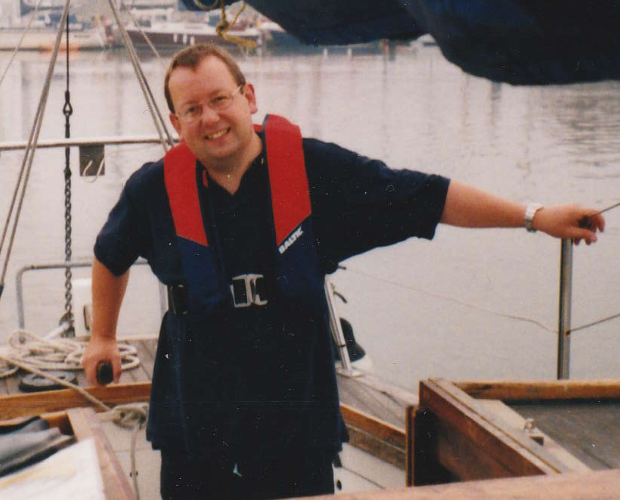
Simon Wagner aboard Zest
Pedigree of The Waterbugs
Myriam Spicka
The HBA's Baltic Correspondent
In the New Year 2016 edition of the HBA Journal, Martin Hansen reported upon Dominic Bailey's investigation that the Waterbug yachts, built by Uphams of Brixham, might be closely derived from Harrison Butler's Zyklon design. Dominic had concluded that the Waterbug seemed to have midship and bow sections that were a remarkably good fit with the Zyklon design, but that Upham's seem to have 'done their own thing' with the stern. Martin further noted that Uphams had built an authentic Harrison Butler boat to the Omega design, Trana, before embarking on a build of sixteen Waterbugs. As I own the ninth Waterbug built, Mowa (1954), I was intrigued by what I read and decided to investigate further.
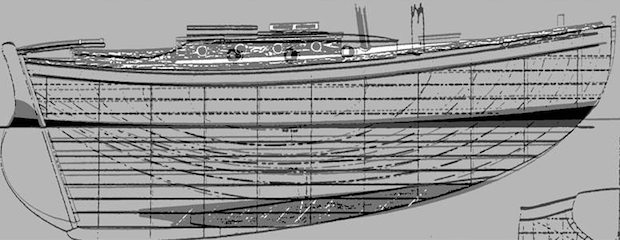
A superposition of Harrison Butler's Cyclone II and Zyklon (enlarged) designs
The use of a computer allows one to compare all of Harrison Butler's designs to each other with ease, scaling a smaller design to the same size as a larger one and superimposing the results. I was particularly taken with the similarity between side elevations of the Cyclone II design of 1928 with the smaller Zyklon design of 1937. Both designs have a keel stepped mast but the Zyklon has this proportionately moved forward, presumably one way of allowing for proportionally lengthened full-headroom accommodation under the proportionally lengthened coach-roof. Mowa's mast is stepped quite far forward on her coach roof, closer in position to that of the enlarged Zyklon than the Cyclone II.
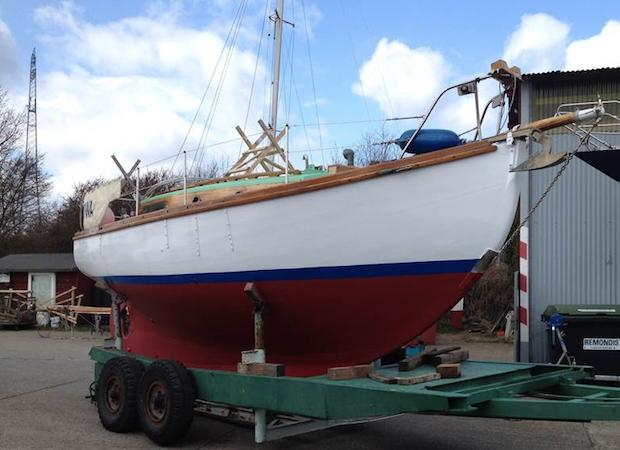
Mowa being made ready to launch, spring 2016
When the moment arrived to have Mowa crained into the water for the 2016 sailing season I arranged for her to be held suspended while I took some orthogonal side elevation photographs. I was after a correctly angled image upon which I could superimpose Harrison Butler's various designs to see which, if any, was a good fit to Mowa.
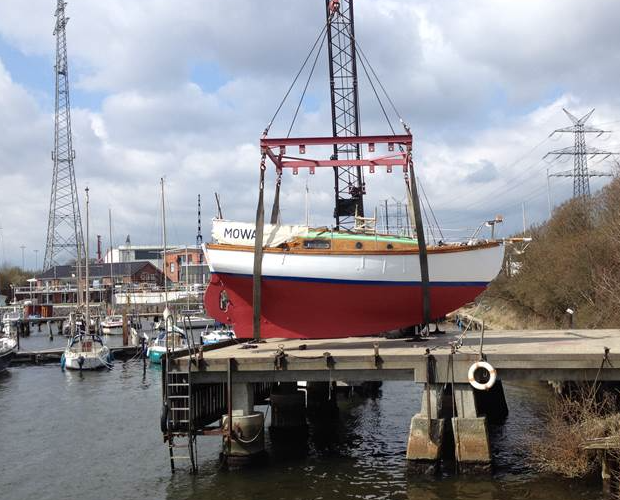
Mowa in suspension
With a suitable photograph thus obtained I first superimposed the 1938 Omega design. The result was disappointing. The Omega design was a poor fit at both bow and stern. I noted, however, that the positioning of the mast was similar.
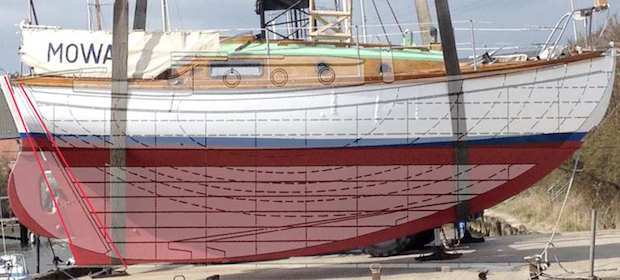
Mowa with Omega design superimposed reveals a poor fit bow and stern.
The two red lines emphasise the very different sterns.
A superposition of the Cyclone II design and the (similar) enlarged Zyklon design over Mowa got me much more excited. The fit across the entire length of the hull seemed good. I had verified with a different Waterbug what Dominic Bailey had found with the Zyklon design superimposed on his Waterbug, Frangipani. What would have been really interesting would have been to now apply similar design superpositions upon a photograph of Mowa's stern. Alas, I failed to get a suitable orthogonal photograph of Mowa's stern.
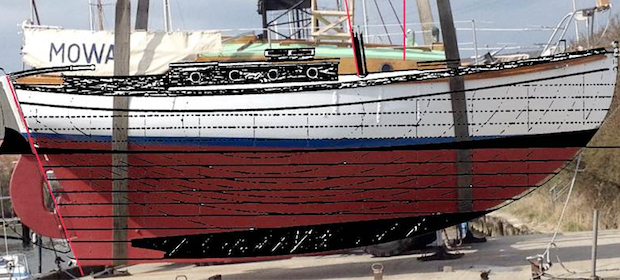
Mowa with Cyclone II design superimposed.
The two red lines indicate the difference in mast position.
In conclusion, I've verified Dominic Bailey's findings, cast doubt upon the alternative suggestion that the Omega design is a better fit, and provided some tantalising hints that Uphams may have returned to Harrison Butler's earlier Cyclone II design for their inspiration for the Waterbugs. The Cyclone II is a boat of very similar size to the Waterbug. Several had been built prior to Uphams' 'production run' of Waterbugs, and they were known to sail well.
It remains to be determined if an end elevation of any of Harrison Butler's designs can provide a good match with Mowa's stern, due to the lack of a suitable photograph.
A final thought: It would be fascinating to use 3D printing to produce physical models of the various Harrison Butler designs, scaled as appropriate, and sit them next to one of Mowa.

Martin Hansen
The HBA's Webmaster & Journal Editor
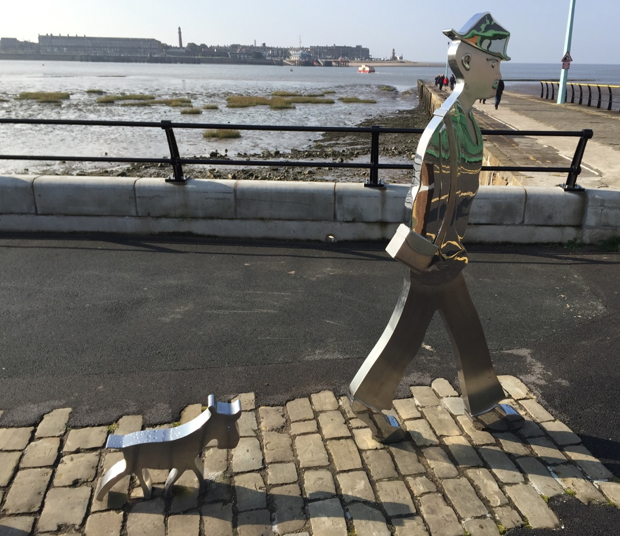
As I passed through Knott End last month, I came across and photographed this tribute to LS Lowry, the celebrated Northern painter, renowned for his industrial paintings of “matchstick men” and women. His summer visits here in the 1940s and 1950s inspired many of his paintings of coastal scenes. From this spot he painted "Jetty at Knott End".
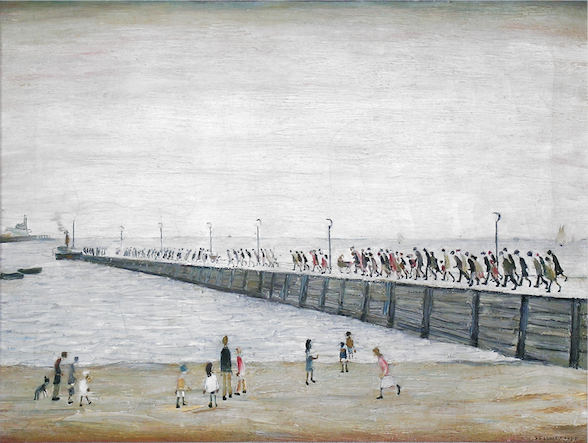
“Jetty at Knott End” by LS Lowry (1957)
Whitstable Bay Beer
Martin Hansen
The HBA's Webmaster & Journal Editor
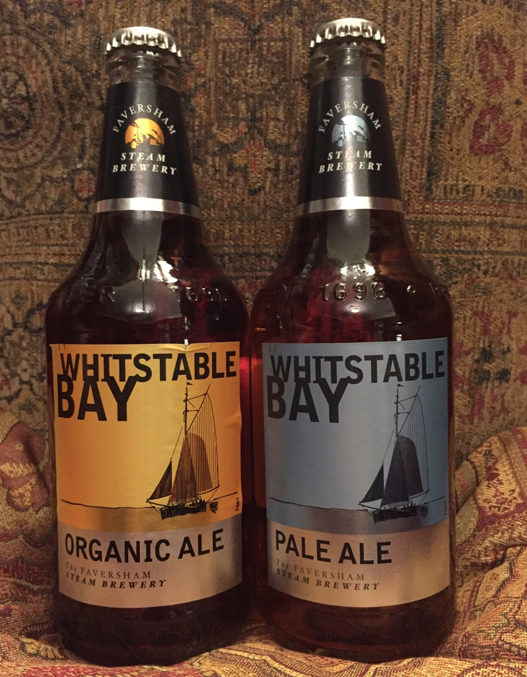
The drink of choice aboard my boat Tramontana is Whitstable Bay Beer. The simple reason is that it was in Whitstable, Kent, that Tramontana was built in 1934 by the Anderson, Rigden & Perkins shipyard. She was originally called Morena and is the only build to Harrison Butler's Cayuca design.
Other Harrison Butler designed boats built at the yard include;
• Ardglass (built 1929, Cyclone II design)
• Minion (built 1931, Cyclone II design)
• Seasalter (built 1931, Fastnet design)
• Solo (built 1932, Cyclone II design)
• Faraway (built 1933, Englyn design)
• Dorothea (built 1934, Khamseen design)
• Peradventure (built 1936, Englyn design)
• Cora A (built 1937, Englyn design)
Three more Anderson, Rigden & Perkins vessels with Harrison Butler connections are Gadfly I (1937), Gadfly II (1946) and Mandamus (1946). Also built at the yard were the Albert Strange designed yachts Ariel (1925) and Galatea (1930).
To all these yachts I say, “Cheers” !

A year long slide in the value of the Pound against the Euro of around 20%,
means that boats for sale abroad, priced in Euros, have higher UK Sterling asking prices.
HB = Harrison Butler Designed
AS = Albert Strange Designed
IF = Invited Friend - The link will give designer detail
Amiri : HB Sinah Design : 1976 : Australia : £26,0125
Cyclone : HB Cyclone Design : 1941 : Netherlands : £13,000
Isabella : HB Omega Design : 1984 : Australia : £18,900
Jacaranda : HB Z4 : 1938 : Frankfurt, Germany : £2,800
Jane : HB Bogle Design : 1939 : Cornwall, UK : £10,000
Jolanda : HB Omega Design : 1996 : Germany : £30,600
Kelana : HB Z4 : 1939, Brighton UK : £300
La Bonne : HB Nursery Class : 1919 : Devon, UK : £POA
Little Kingfisher : HB Cyclone Design : Solent, UK : £12,500
Saltwind : HB Z4 : 1940 : Spain : £19,900
Sea Harmony : AS : 1937 : Massachusetts, USA : £25,000
Senorita : HB Cyclone II Design : 1934 : New Zealand : £4,000
Spindle : IF : 1983 : Plymouth, UK : £5,000 (open to offers)
Tamaroa : HB Thuella Design : 1973 : £9,000
Tally Ho : AS : 1909 : West Coast, USA : £25,000
Thalamege : HB : Netherlands : £6,750
Thule : HB Yonne Design : 1934 : Netherlands : £17,700 -£22,200
Watermaiden : HB Rose of Arden : 1939 : Cornwall : £15,950
Witte Walvis : HB Z4 : 1939 : Netherlands : £5,000
Zebedee : HB Z4 : 1938 : Ireland : £4,750
Zephon : HB Z4 : 1950 : Shetland, UK : £4,500
Zircon : HB Z4 : 1938 : Orwell, UK : £7,950
Zingara : HB Askadil Design : 1936 : USA : £POA
The Gentrification of Barmouth
Lee Shore
The photograph is of a new pub that has recently opened in Barmouth, on the West coast of Wales. One of the town's most famous former residents is the sailor and mountaineer, Bill Tilman (1898-1977). He is the inspiration behind this stylish and tasteful new high street venture. Tilman's books about his adventures had become impossible to obtain at reasonable prices but Lodestar Books are systematically republishing several of his classic titles. I can't think of a more convivial place in which to read them.
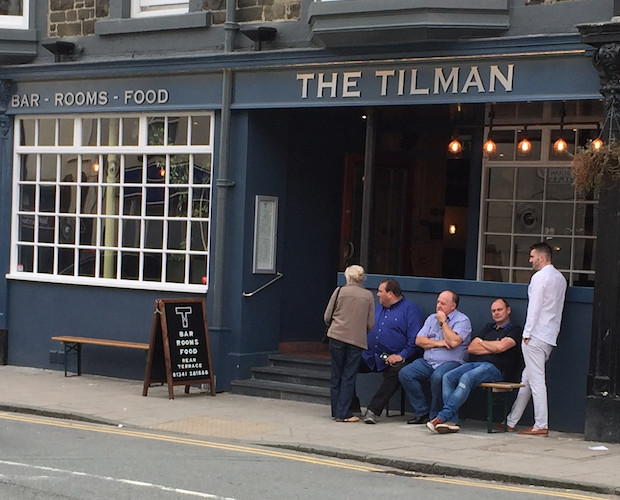

| | |